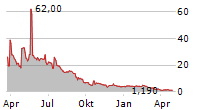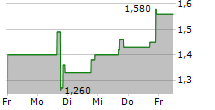On Track To Be First Mover In $7Bn Addressable Market With No Current Therapeutic Options
By: Benzinga Staff Writer
CARDIFF, UK / ACCESS Newswire / September 8, 2025 / Biodexa Pharmaceuticals PLC. (NASDAQ:BDRX), a late clinical-stage biopharmaceutical company developing a pipeline of innovative products for the treatment of diseases with unmet medical needs, has launched its registrational Phase 3 trial of eRapa - its proprietary encapsulated form of rapamycin being developed for the treatment of familial adenomatous polyposis (FAP), a debilitating disease of the lower GI tract.

This post was written and published as a collaboration between the in-house editorial team at Benzinga and Biodexa Pharmaceuticals PLC. with financial support from Biodexa. The two organizations work to ensure that any and all information contained within is true and accurate as of the date hereof to the best of their knowledge and research. This content is for informational purposes only and not intended to be investing advice.
Multiple Key Milestones So Far in 2025
The company just enrolled the first patients in the Phase 3 trial. Earlier this year, its collaboration partner, Rapamycin Holdings, Inc., which does business as Emtora Biosciences, was awarded an additional $3 million grant by the Cancer Prevention & Research Institute of Texas bringing the total non-dilutive funding for the Phase 3 trial to $20 million. Together with the match already paid into escrow by Biodexa, the Phase 3 trial is basically funded. The company also recorded two other important milestones earlier this year: Fast Track status from the U.S. Food and Drug Administration and Orphan Drug designation from the European Commission.
All three milestones put the company in a clear leadership position in advancing a drug that could bring relief to people suffering from this largely genetic disease.
A Rare Disease But A $7Bn Addressable Market
FAP causes hundreds or thousands of precancerous polyps to grow throughout the lower gastrointestinal tract. There is no approved therapeutic option for treating FAP patients, for whom active surveillance and surgical resection of the colon and/or rectum remain the standard of care. People with FAP, which usually appears in the patient's mid-teens, end up eventually having their entire colon and rectum removed. If left untreated, there is a near 100% chance the patient will develop colorectal cancer.
Biodexa Pharmaceuticals (BDRX) | |
ADS price | $5.65 |
ADSs outstanding | 619,523 |
Market capitalization | $3.5M |
There are reported prevalence's of FAP of one in 5,000 to 10,000 population in the U.S. and one in 11,300 to 37,600 population in Europe. Based on the lowest estimates of prevalence of 1/10,000 and 1/37,600 in the US and Europe, respectively, the adult populations in each territory of approximately 258 million and 358 million and the median annual cost of approved non-biologic orphan drugs in the US of $206,176, the combined US / European addressable market for eRapa in FAP is approximately $7.3Bn.
eRapa Could Have First Mover Advantage
Treating FAP has proven difficult over the years. While Pfizer Inc.'s (PFE) Celecoxib (Celebrex), a Cox-2 inhibitor, was approved to reduce the number of polyps for FAP about eight years ago, it failed a post approval study and the label was pulled. Recursion Pharmaceuticals, Inc. (RXRX) is developing REC-4881 and Tempest Therapeutics Inc (TPST) is developing TPST-1495, both for FAP and both are in Phase 2. Biodexa, with compelling Phase 2 data in hand, is already in Phase 3 and could have first mover advantage in a significant market. Orphan drug designation provides market exclusivity for eRapa of 7 years and 10 years from launch in the U.S. and Europe, respectively.
Phase 3 Trial Fueled By Additional Grant On Back Of Compelling Phase 2 Data
Biodexa's Phase 3 trial is a double-blind, placebo-controlled trial in 168 patients, randomized 2:1 drug to placebo. It is expected that the study will be conducted in approximately 30 clinical sites across the U.S. and Europe. The U.S. component of the study is being managed by LumaBridge, and the European component by Precision for Medicine LLC.
The Phase 3 trial advanced after Biodexa completed a Phase 2 trial that demonstrated a 17% median decrease in overall polyp burden and an overall non-progression rate of 75% at 12 months. In cohort 2, which deployed the dosage regimen selected for the Phase 3 trial, the median decrease in polyp burden was 29% with a non-progression rate of 89% at 12 months. Following that study Biodexa held a Type C meeting with FDA that included a discussion of the statistical plan, the safety database and, most importantly, a composite endpoint for the Phase 3 study. FDA representatives from both the gastroenterology and oncology divisions provided valuable input into the proposed program.
On the back of the Phase 2 data, the Cancer Prevention & Research Institute of Texas (CPRIT) initially awarded a $17 million grant to support the Phase 3 program. This was increased to $20 million with the most recent award. Overall, CPRIT has awarded $2.9 billion in grants to Texas research institutions and organizations focused on treating and preventing cancer. CPRIT funding has advanced scientific and clinical knowledge and provided 7.4 million life-saving cancer prevention and early detection services reaching Texans from all 254 counties.
Featured image from Shutterstock.
This post contains sponsored content. This content is for informational purposes only and is not intended to be investing advice.
Click here for more information on Biodexa Pharmaceuticals.
Contact:
Stephen Stamp, CEO, CFO
ir@biodexapharma.com
Important notice, please read: The information and statistical data contained herein may contain forward-looking statements that reflect the company's intentions, expectations, assumptions, or beliefs concerning future events, including, but not limited to, expectations with respect to FDA and other regulatory bodies approval of new products, technology, and product development milestones, the ability of the company to leverage its product development and negotiate favorable collaborative agreements, the commencement of sales, the size of market opportunities with respect to the company's product candidates and sufficiency of the company's cash flow for future liquidity and capital resource needs and other risks identified in the Risk Factor Section of the company's Annual Report and any subsequent reports filed with the SEC. We do not undertake to advise you as to any change in this information. The forward-looking statements are qualified by important factors that could cause actual results to differ materially from those in the forward-looking statements. In addition, significant fluctuations in quarterly results may occur as a result of varying milestone payments and the timing of costs and expenses related to the company's research and development programs. This is not a solicitation of any offer to buy or sell. Redington, Inc. is paid by Biodexa Pharmaceuticals PLC to provide investor relations services, and its employees or members of their families may from time to time own an equity interest in companies mentioned herein.
SOURCE: Biodexa Pharmaceuticals
View the original press release on ACCESS Newswire:
https://www.accessnewswire.com/newsroom/en/healthcare-and-pharmaceutical/biodexa-moves-into-phase-3-with-erapa-for-fap-with-first-patients-enr-1069300

